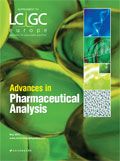Introduction
Special Issues
An introduction from the guest editors of this special supplement from LCGC Europe focusing on some recent developments in pharmaceutical analysis.
An introduction from the the guest editors of this special supplement from LCGC Europe focusing on some recent developments in pharmaceutical analysis.
The development of fast and reliable methods for drug analysis is of paramount importance to the pharmaceutical industry. These analyses support drug discovery and all stages of development up to manufacturing and quality control/accuracy.

Frank David
Today the pharmaceutical market is shaped by a diverse set of molecules ranging from small natural and synthetic molecules up to large recombinant proteins produced in living organisms. Synthetic small molecules still dominate the pharmaceutical market but it is expected that within the current decade, more than 50% of new drug approvals will be large biomolecules. Although analytical challenges are different when one is confronted with small or large molecule therapeutics, application of the full arsenal of state-of-the-art analytical techniques is mandatory for both drug substance classes.

Pat Sandra
In recent years innovations in separation science and mass spectrometry have been very impressive and offer the pharmaceutical analyst very powerful tools to combine accuracy, precision, selectivity, sensitivity, versatility and ease of automation with high throughput, high productivity and high resolution.
In the context of a special supplement from LCGC Europe on advances in pharmaceutical analysis, giving a complete and detailed overview of recent innovations is unrealistic. Only some aspects of drug substance and drug product analysis will be highlighted with emphasis on chromatography, mass spectrometry and their hyphenation as analytical techniques. The recent developments in mass spectrometry have been very impressive especially. Even in quality control, triple quadrupole MS systems, both in combination with gas chromatography (GC) and with liquid chromatography (LC), are more and more replacing single quadrupole systems, as they offer higher selectivity and higher sensitivity. In addition, for the identification of impurities or for the characterization of biopharmaceuticals, the (r)evolution in mass spectrometric equipment is enormous. High resolution accurate mass systems, including quadrupole time-offlight (Q–TOF-MS), orbitrap MS and ion mobility technology, give researchers additional weapons to tackle challenging problems. New direct MS introduction tools, such as "direct analysis in real time" (DART) or high throughput SPE–MS, open up new perspectives for extremely high throughput in quality control or pharmacokinetic studies.
In this world of increasingly powerful MS systems, one should not underestimate the importance of state-of-the-art separation techniques. It is clear that the role of GC is limited in view of the shift towards biopharmaceuticals, however, for the characterization of small molecules and in metabolomics, GC will continue to play an important role. The recent developments in LC, including new column technologies (sub-2 µm, core–shell), nearly universal and more sensitive detectors and complementary LC modes, also offer a wide spectrum of possibilities for pharmaceutical analysis.
It is obvious that all these developments cannot be discussed within the frame of this supplement. Moreover, analysis of drugs and their metabolites in biological samples such as blood, plasma, urine or hair are not discussed in this supplement.
In the first article the challenges of bio-therapeutics are highlighted and solutions by high resolution chromatography hyphenated to high resolution mass spectrometry are proposed and discussed.
The separation modes in LC that have received most attention recently with regards to pharmaceutical analysis are hydrophilic interaction liquid chromatography (HILIC) and supercritical fluid chromatography (SFC). The features of HILIC for the analysis of polar and ionizable drug substances and metabolites are reviewed by colleagues from the School of Pharmaceutical Sciences, Universities of Geneva and Lausanne, Switzerland.
The revival of super- and subcritical fluid chromatography for both chiral and achiral applications is discussed and illustrated by scientists of the Centre for Pharmaceutical Research, Vrije Universiteit, Brussels, Belgium. Interesting to note is that both groups included considerations on core–shell particles and comparisons with porous particles.
The last contribution briefly describes the analysis of potential genotoxic impurities (PGIs) in drug substances and products by gas chromatography–mass spectrometry (GC–MS) and liquid chromatography–mass spectrometry (LC–MS). This is an emerging topic in pharmaceutical quality control and challenging for the pharmaceutical analyst because traces down to the low ppm and even ppb level have to be determined.
We hope these short reviews will provide the readers with some interesting, albeit brief, information on some recent trends in pharmaceutical analysis.
Pat Sandra and Frank David, Research Institute for Chromatography, Kortrijk, Belgium.

New Method Explored for the Detection of CECs in Crops Irrigated with Contaminated Water
April 30th 2025This new study presents a validated QuEChERS–LC-MS/MS method for detecting eight persistent, mobile, and toxic substances in escarole, tomatoes, and tomato leaves irrigated with contaminated water.

.png&w=3840&q=75)

.png&w=3840&q=75)



.png&w=3840&q=75)



.png&w=3840&q=75)









